|
Tags: culture | development | god | goddess | maritime
I. Island Nation, Seafaring People
Oceans occupy 70 percent of the surface of the Earth and as such their presence can be seen in the progress of human civilization. In the 16th century, the world entered the Age of Sail, and all coastal nations benefited from this development.
The birth of Taiwan, an island in the West Pacific, was closely connected to the ocean, and the people of this island have long engaged in marine pursuits. Not only are its industries based on sea-bound trade, the lives and customs of its people are also bound up with the sea and an oceanic climate. Taiwan's geographic position, geographic factors, the rise and fall of the tides, seaports, business and trade, and the immigration of peoples from across the ocean are all intimately tied to the sea and are some of the characteristics of Taiwan's culture.
All people of Taiwan have some experience with the sea. Some peoples, including the pingpu (plains) peoples, understood how to benefit from oceanic currents and trade winds when they set sail for faraway places. The Puyuma people of Eastern Taiwan worship a sea deity, while the Yami people on Orchid Island are known for their seafaring skills.
When Taiwan lay within the sphere of influence of the Manchu Ching Empire, Han people from Fujian and Guangdong ventured across the sea to Taiwan. The adventurous and hearty spirit they exhibited while battling natural forces was the wellspring out of which sprouted the vitality and tenacity of modern Taiwan.
Additionally, the million or so people who followed the KMT government to move to Taiwan in 1949 further diversified the island's population. Having already lived in Taiwan for two to three hundred years, the Ching era immigrants were thriving, while the new immigrants have now borne their third generation and become increasingly localized. Moreover, although these two groups of immigrants came at different times, from different places, and with different backgrounds, that they all crossed the same salty sea has created in them a collective memory. "Children of the Sea," is an apt description of Taiwan's people.
Despite its limited natural resources, Taiwan created an economic miracle the envy of the entire world built upon an export-oriented strategy. The prosperity of fisheries both littoral and oceanic has added to Taiwan's oceanic character. The people of Taiwan would do well to take to heart their cultural heritage and view their history through ocean-colored lenses.
II. A Procession of Sea Deities
|

A 136-meter-tall Matsu, the largest Matsu statue in Southeast Asia, in Jhunan.
Photo by: GIO Photographer (1992-02-02)
|
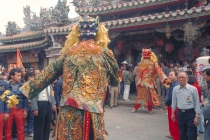
The Beigang Matsu Inspection Tour is underway.
Photo by: GIO Photographer
|
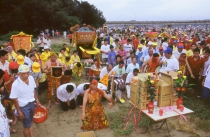
A religious activity held by Chunan Cihyu Temple.
Photo by: GIO Photographer
|
|

In early times when plagues were common, people burned ceremonial boats, believing that they would placate the gods of pestilence and bring spiritual protection. This tradition is still followed today, with the burning of the “Wang Yeh” boats as the climax of the ritual.
Photo by: GIO Photographer
|
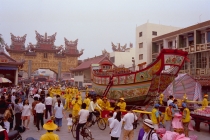
The Wangyeh Boat Festival held in Donggang.
Photo by: GIO Photographer (2000-10-22)
|
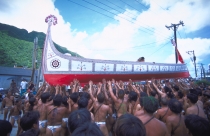
The Yami People's Boat Festival.
Photo by: GIO Photographer (2001-07-02)
|
The Ma Zu Belief
Human beliefs and culture are bound up with the sea. From antiquity, the sea has been seen as both treacherous and mysterious and, therefore, has inspired many beliefs.
Among Taiwanese beliefs born of the sea, the most important is the worship of Ma Zu, Goddess of the Sea. When she lived, Ma Zu was named Lin Mo-niang. Legend has it that this woman became a deity at Meizhou in Fujian. Ma Zu is the most popular guardian deity of those Taiwanese who live out much of their lives upon the sea. Images of Ma Zu have, over time, changed from being those of a young lady and a heavenly princess to a heavenly queen and elderly woman. These changes came about as a result of what activities Taiwan's people held at sea.
At most temples along Taiwan's coast, the main deity worshiped is Ma Zu. In the past, unfavorable weather and poor seafaring skills made sea crossings difficult. Ma Zu became more popular in the wake of bans on maritime activity and other political machinations. Temples dedicated to Matsu now number 53 and were built in many coastal cities. Those most well-known temples are Zhenlan Temple in Dajia, Haotian Temple in Wuxi, and Wanxing Temple in Dadu. Such temples are also found in other areas around Taiwan, and include the Tianhou (Heavenly Queen) Temple at Magong on Penghu Island, Chaotian Temple in Beigang, Tianhou Temple in Tainan, Tianhou Temple in Lugang, Ciyu Temple in Zhonggang, and Guandu Temple in Beitou. Major related religious events are the Ma Zu tour and Ma Zu's birthday, which always attract a good deal of attention and participation. The most famous activity is the tour of the Ma Zu of Zhenlan Temple at Dajian, which continues for eight days and seven nights and often involves up to 100,000 people. The destination for this tour was formerly Chaotian Temple in Beigang, but since 1989 it has been Fengtian Temple in Xingang. Every year, this event attracts large numbers of people from across the island.
The God of Water and Xuan Tian Shang Di
The God of Water is another deity related to the sea. It is the embodiment of all deities related to water, such as Dayu of the Xia Dynasty, who is worshipped for his success in flood control as well as the poets Quyuan—who drowned himself in a river after the death of the emperor he had served—Li Bai, and Wang Bo. In the past, when people on the sea encountered danger, they would ask the God of Water for help. Alongside the Zushi Temple in Sanxia, there is a humble structure known as the Zaishufu at which Xuan Tian Shang Di is worshiped. The position of the star Polaris never wavers in the sky, so ancient navigators used it as their guide while at sea. Hence, Xuan Tian (Mandarin for Polaris) has long been worshiped by seafarers from Taiwan. During the Ching Dynasty, immigrants from what is now China sailed down the Danshui River in Taiwan, settling in Sanxia. They counted on Polaris to guide them there. The Zushi Temple in Sanxia has its origins in worship taking place at Anxi in Fujian.
The Wang Ye Belief
Worshipping Wang Ye and performing rituals related to him are rousing religious events. In Taiwan, there are at least 132 versions of Wang Ye. The temples dedicated to them are scattered across the nation and far outnumber other temples. Temples dedicated to various versions of Wang Ye include the Xilaian Temple in Tainan, Daitianfu Temple in Nankunshen, Five-king Temple in Matou, and Wufu Temple in Haipu. The Tainan area has the highest number of such temples.
Han people once believed that remote mountains, seas, and rivers were the haunts of ghosts and demons. As these were considered to be dangerous places, incantation rituals were held every few years to exorcise the evil spirits. Such practices had the dual purpose of calming the people's fears and entertaining them. Among the major activities still celebrated today, Burning Wang Ye's Boat Ceremony observes a tradition born during the Ching era. Wang Ye's Boat is burned, instead of being sent out to the sea, as a symbol of destroying pestilence.
Sea Beliefs Among Indigenous Peoples
In addition to the sea-related beliefs developed by the Han people, indigenous peoples developed similar beliefs. These include the fish-catching ceremony of the Ami, the sea-god worship of the Puyuma, and the flying fish and boat ceremonies of the Yami people. The Yami regard flying fish as a heaven-sent gift, so they hold a ceremony praying for a bountiful catch every year during the flying fish season, which lasts from March to June. Also, boats are the key to the livelihood of the Yami, so when a new boat is launched they hold a ceremony to pray for its safe return and for a bumper catch.
III. Impressions of the Sea and Mountains
|
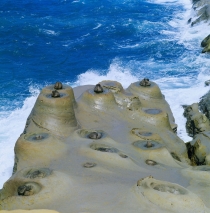
The natural scenery in the Northeast Coastal Scenic Area.
Photo by: GIO Photographer (1993-10-26)
|
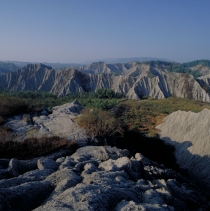
The salinity in the soil of Caoshan Moon World, located on the border between Tainan County and Kaohsiung County, is high, making it difficult for plants to grow.
Photo by: GIO Photographer (1994-11-08)
|

Marble erosion along the Liwu River in Hualien County has created the Taroko Gorge on the Central Cross-island Highway.
Photo by: GIO Photographer
|
|
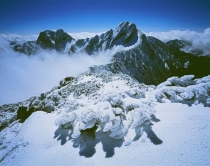
Winter snow stays as late as April or May on the slopes of Taiwan's highest peak, Mount Jade, which is also known as the "snowy mountain of the tropics."
Photo by: GIO Photographer
|
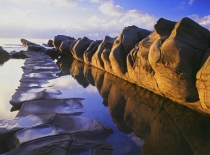
Unusual sandstone formations and eroded rock platforms are ubiquitous features at Little Yeliu Scenic Area in Taitung.
Photo by: GIO Photographer
|
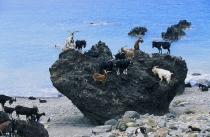
The coast of Orchid Island.
Photo by: GIO Photographer (2001-07-01)
|
This Oceanic Island Is Also One of High Mountains
The birth of Taiwan was quite dramatic. The movement of the Earth's Eurasian Plate, the formation of two island chains, and the collision between an island chain and a continental plate, in which the Philippine Sea Plate has played a crucial role, were all a part of the story of Taiwan's birth.
The Philippine Sea Plate was formed after the magma thrown up by the eruption of an oceanic volcano cooled and hardened. This new plate pushed the sea bottom crust apart and caused the oceanic plate to move.
When this oceanic plate collided with the Eurasian Plate, it created the island chain that includes the Okinawan Archipelago and the Okinawa Trench. Broken off from the Eurasian Plate, the South Sea Islands were formed, which collided with the Philippine Plate and created the Manila Trench, Luzon island chain and Luzon Trench.
The Philippine Plate's continued northwesterly movement caused the Luzon Island chain to brush up against the Eurasian Plate. This collision pushed up the rock mass and volcano at the bottom of the ocean and created the island of Taiwan. This history shows why Taiwan is an island of high mountains.
Northward and Southward Oceanic Currents
Human migration, cultural dissemination, and maritime developments are greatly affected by oceanic currents. The current that affects Taiwan most is the Kuroshio, also known as the Japan Current, which passes by Taiwan's east coast.
The northern equatorial current flows from California, turns northward after passing the Philippines, and became the Kuroshio. The Kuroshio moves from eastern Japan toward North America and becomes a North Pacific drift current. When it encounters the continent upon which sit Canada and America, it splits into the southerly California current and northerly Alaska current.
When the Alaska current encounters the Aleutian Islands, it turns westward and becomes the Aleutian current. Hitting Asia, the Aleutian current merges with waters from the Bering Sea, becoming a cold current in the area around Kuril Island.
The currents around Taiwan may be divided into summer currents and winter currents. In summer, the Kuroshio flows by the island's Eastern coast, whereas the current created by southwesterly winds flows northward into the Taiwan Strait.
Temperatures in the South China Sea and Kurishio are high, causing high humidity and an increased water temperature around Taiwan in summer. In winter, a branch of the Kuroshio flows into the Taiwan Strait. At that time, strong northeast winds blow north of the Taiwan Strait, causing oceanic currents to flow southwards. As a result, the area around the southern cities of Kaohsiung and Pingtung, affected by the branch of the Kurishio, witnesses high humidity and temperatures while the northern part of the island, including the cities of Keelung and Taipei, remains cooler as it is affected by the northeastern winds and cold currents.
The Rising and Ebbing of Tides
The waters off the Western coast of Taiwan are shallow but tidal differences are great, completely the opposite of what things are like on the Eastern coast. Oceanic currents also affect the tides. Vertical changes in oceanic water levels are known as the "morning and evening tides," while horizontal movement is called a "tidal current." "Oceanic current" refers to a flow in a fixed direction caused by seasonal changes. Oceanic currents influence both tidal currents as well as morning and evening tides. These latter are also affected by climatic change, events such as typhoons, rainfall, and seasonal changes in temperature. When a typhoon passes overhead, its winds can cause greater changes in the water level.
Tides greatly affect all sorts of human activities, ranging from pulling a ship alongside a pier, taking a ship out to sea, and designing and building a levee or port, to smaller-scale acts like leisurely pursuing of crabs and shellfish. To fish, a person must choose the best time according to the ebb and flow of the tide. Even the best time for watching sea birds is dictated by the tide. Hence, humanity's maritime activities are closely bound up with the rising and falling of the tide.
IV. Living off the Sea
|

Fishermen are pulling in a fishing net.
Photo by: GIO Photographer (1952-00-00)
|
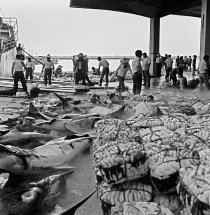
Kaohsiung’s Cianjhen Port is the biggest fish market in southern Taiwan. The photo shows a ship is unloading.
Photo by: GIO Photographer (1976-10-31)
|

Oyster breeders are inspecting the oyster shed as the tide goes out.
Photo by: GIO Photographer (1979-00-00)
|
|
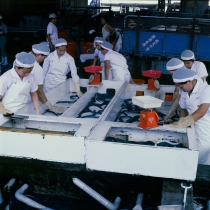
Workers are sorting eels for export.
Photo by: GIO Photographer (1981-05-07)
|
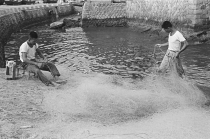
Residents are arranging fishing nets in a Yeliou fishing village.
Photo by: GIO Photographer
|

An aerial shot of the aquaculture industry in Taiwan.
Photo by: GIO Photographer
|
Since time immemorial, people on Taiwan have been skillful at catching fish and have enjoyed eating fish. At Kenting and Ouluampi in southern Pingtung County, archeologists have unearthed huge caches of weights used on fishing nets, as well as a variety of fish bones, shells, shell scrapers, and other fishbone tools. This indicates that ancient peoples knew and made use of marine resources.
Taiwan is blessed with abundant fishing resources throughout the year. This has given rise to the saying, "When in the mountains, live off the mountains; when on the sea, live off the sea." Fish are the witnesses to Taiwan's history. Take the Formosan landlocked salmon (Oncorhynchus masou formosanus) at Qijiawan, for example. Because of topographic changes during the last Ice Age, the fish was trapped in the river, unable to return to the sea. Today it is considered a national treasure. The Yami people of Orchid Island depend on the flying fish found there for their livelihood. These fish even dictate the people's activities, demographic structure, and cultural sense. In Taiwan, indigenous peoples created the names of certain fish. For instance, the local names of the Jiala fish in the north and shimu (milky) fish in the south come from Pingpu languages.
During their colonization of Taiwan, the Japanese liked to eat "wood fish" (bonitoes dried until they had become like wood). As such, bonitoes from the seas to the northeast of Taiwan became a prized catch. Because Japanese like to eat sashimi, Taiwan's fishermen learned to catch marlin with nets and harpoons. At that time, there was even a whaling base at Nanwan near Kenting in southern Taiwan. All these developments were brought about by Japanese colonial rule. The Japanese also brought to Taiwan power fishing boats and fish detection techniques. Much of the fishing equipment used by Taiwan's fishers today, as well as fishing jargon, was introduced by the Japanese.
Aquaculture has always been an advanced operation in Taiwan. In recent years, the value of coastal and near-sea fishing has declined, but as Taiwan's oceanic fishing ranks 6th in the world, Taiwan is a key player in this industry. The long-term efforts of the government and the private sector in renovating and improving fisheries have made aquaculture highly successful. The Taiwan tilapia is the pride of the industry. It has both made a name for Taiwan's sea products and opened the international market for Taiwan.
V. Portside Views
|
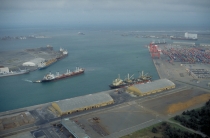
An aerial shot of Taichung Harbor located in Taichung County.
Photo by: GIO Photographer (1989-10-13)
|
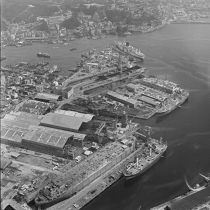
An aerial shot of Keelung Harbor.
Photo by: GIO Photographer (1978-07-15)
|
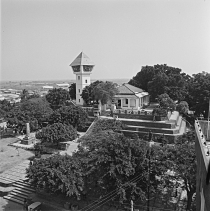
Anping Fort (Old Fort Zeelandia) in Tainan City was the 1st fort built by the Dutch in Taiwan. It was once the economic and political center in Taiwan.
Photo by: GIO Photographer (1982-09-28)
|
|
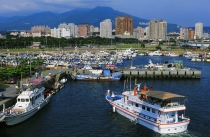
Tamshui Fishermen’s Wharf.
Photo by: GIO Photographer (2003-07-03)
|

A breathtaking scene taken in Suao Harbor.
Photo by: GIO Photographer
|

A night scene of Kaohsiung Harbor, the largest harbor in Taiwan and the 6th largest container port in the world.
Photo by: GIO Photographer
|
Seaports are the ingress and egress that allow for oceanic transport. They are also hubs of trading activity. As a result of mass migration from Fujian and Guangdong Provinces to Taiwan during the Ching Dynasty, shipping traffic between the two areas was busy. Areas around ports became the most developed. The Ching government designated Taiwan's Fucheng (now called Tainan), Lugang, and Bunga as the three ports allowed to conduct cross-Taiwan Strait trade.
Fucheng, developing into an economic powerhouse, became Taiwan's political center. Lugang became the rice trading post for central Taiwan after the Bapao Canal was completed and was also a major port for trade with Quanzhou in Fujian. At the time, shipping lines were fairly well determined between ports in Taiwan and China. This was due mostly to oceanic current, wind direction, and the division of labor concerning various products.
Vestiges of Taiwan ports can still be seen. These included Wushi in Ilan; Danshui in Taipei; Nankan in Taoyuan; Nanliao in Hsinchu; Houlong and Daan in Miaoli; Wuxi and Longjing in Taichung; Lugang in Changhua; and going southward down the coast: Beigang, Dongshi, Budai, Tainan, Kaohsiung, and Donggang. Along the 300-kilometer coastline, there was a port roughly every 40 kilometers. These ports were economic entities unto themselves, and cities grew up around them.
In 1924, the ports of Keelung and Kaohsiung developed into cities. Today, Kaohsiung has become a leading container transshipment point and one of the two metropolises in Taiwan along with Taipei in the north. In addition to Kaohsiung and Keelung, Taichung, Hualien, and Suao have also been built into international ports.
Ports are a part of people's lives even today as leisure spots. At many of them, crowds of visitors can be seen eating seafood. Along the docks in Danshui and Qijing, students, commuters, and tourists can all be seen boarding ferries. Each port has its own unique stories for people to tell and to enjoy hearing.
VI. Ships at Sea
|

The canoe is an important method of transportation for the Yami people on Orchid Island. Here, two residents on Orchid Island are carving traditional patterns on a canoe hull.
Photo by: GIO Photographer (2001-07-01)
|
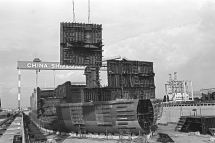
"Plans for establishing China Shipbuilding Corp. was drafted as early as 1967 and, thanks to the efforts of the Ministry of Economic Affairs, was formally approved in July 1973. Located at No. 3 of Chung Kang Road in Kaohsiung’s Linhai Industrial Park, it is one of the Ten Major Construction Projects. Shown here is a photo of the shipyard with a view of an unfinished ship’s structure.
Photo by: GIO Photographer (1977-09-23)
|
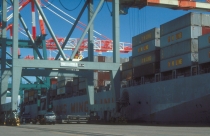
A container ship owned by Yang Ming Transport Corporation is docking at the container terminal of Keelung Harbor.
Photo by: GIO Photographer (1988-05-25)
|
|
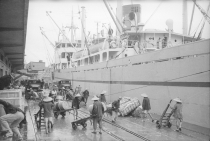
Workers are transporting cargo at a busy harbor.
Photo by: GIO Photographer (1952-00-00)
|
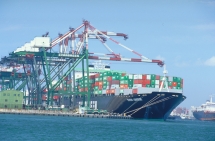
A container ship owned by Evergreen Marine Corp. (Taiwan) is docking at the container terminal of Kaohsiung Harbor.
Photo by: GIO Photographer (1998-04-01)
|

A yacht is being built in Taiwan.
Photo by: GIO Photographer
|
Relics unearthed in Taiwan show that people, even in ancient times, were experienced at taking to the sea. It was found that the articles unearthed at the mouths of the Danshui and Liwu Rivers were quite similar, proving that brisk trade flourished even in ancient times. The shoulder bones unearthed at Shisanhang exhibited signs that the bodies of men at that time were well-developed; suggesting that rowing may have been a daily activity. Such booming maritime activities would not have been possible if not for the existence of well-built boats.
Judging from the traffic between the East and the West, we can say that Taiwan was no less important in the 17th century than New York. The archives of the Dutch East India Company recorded the great number and style of ships that played the waters between Taiwan, China, Japan, and other nations.
Among the boats in service at that time, the Austronesians employed twin-body boats while the Han preferred bamboo rafts. The Yami people on Orchid Island used boats made of 23 or 26 pieces of timber. Making canoes was not difficult, but their skill in waterproofing wooden boats shows how advanced their boat-making techniques were. Clapboard boats (like the Tatara and ten-man Chinurikuran styles used on Hongtou Island) for ferrying people across the sea are considered to be works of art. Pingpu peoples were found to have used outriggers to make long-range voyages, taking advantage of oceanic currents.
Worthy of note is that Taiwan's shipbuilding industry has won international recognition and, in recent years, has earned the name "Kingdom of Yachts."
Shipbuilding is not only aimed at transportation, as it is a basic heavy industry that can safeguard a nation's sea power and the development of trade. In 1970, the China Shipbuilding Corporation was established at Xiaogang in Kaohsiung, and is involved in shipping, trade, and national defense. Based on its robust shipbuilding capabilities, Taiwan, a ship itself floating in the Pacific, can make connections with every corner of the world.
Marine transport
To the people of prehistoric Taiwan, the sea was not a barrier to movement but rather their main transport route. That Taiwan's peoples had contact with Southeast Asia, Oceania, and even Madagascar off Africa was tied to the fact that they employed outriggers. A study of linguistics and DNA suggests that Taiwan's indigenous peoples were once important among Austronesian peoples.
Sea transport's expansion marked the beginning of East Asia's importance in international trade. Taiwan, surrounded by the ocean and a transportation hub, became a center of transshipping. In terms of marine transport, the Taiwan Strait long ago became a shipping lane and Taiwan a point of trade.
Taiwan's resources do not allow for self-sufficiency. As such, foreign trade is an important means to make up for shortages. Over the past several hundred years, maritime businesses have not once failed to press forward.
During the period of Japanese colonization, Taiwan was made into a supply base as well as a setting-out point under "southward expansion" and other policies. This was a great boon to the shipping industry. After the Second World War, the development of shipping reflected strong demand created on the one hand by economic development and on the other by a change in international politics. Taiwan's marine transport companies had to compete with major global shipping firms by adjusting their strategies (such as by using flag-of-convenience ships).
In addition to meeting demands made by the economic and political environment, improvements in hardware have also played an important role in the maturation process of the shipping industry. Of recent improvements, the first revolution can be said to have been the move from sail to steam. Later, the development of landing stages and unloading equipment aided the growth of the shipping industry. But not until the middle of the 20th century when containers began to be used did the second shipping revolution begin. Containers led to the rebirth of the shipping industry.
The major shipping enterprises in Taiwan are Evergreen Marine Corp., Yang Ming Marine Transport Corp., and Taihang Enterprise Co. They demonstrate the vitality of Taiwan's shipping business and Taiwan's maritime spirit.
Taiwan Image - Photo Archive
Text and images are provided by Ministry of Foreign Affairs, Republic of China (TAIWAN)
|









































